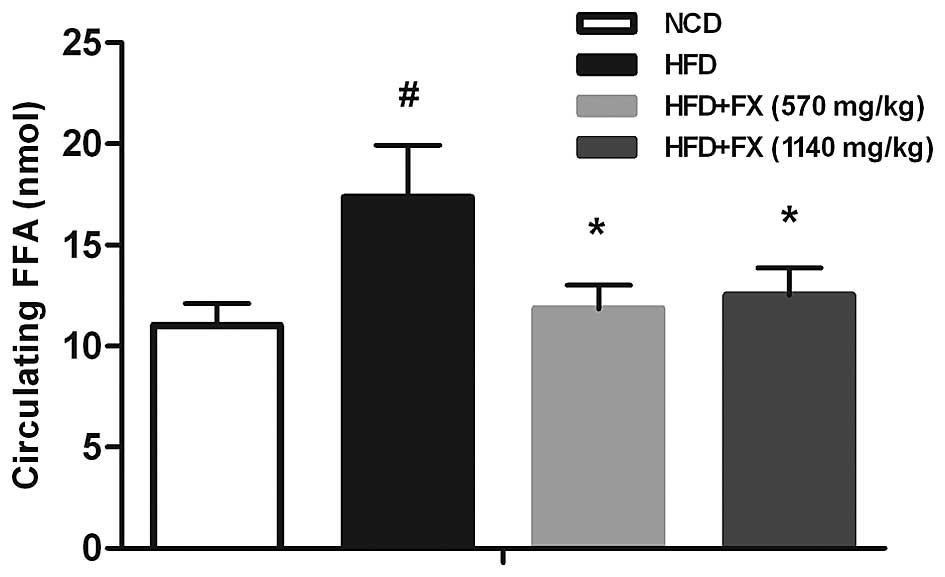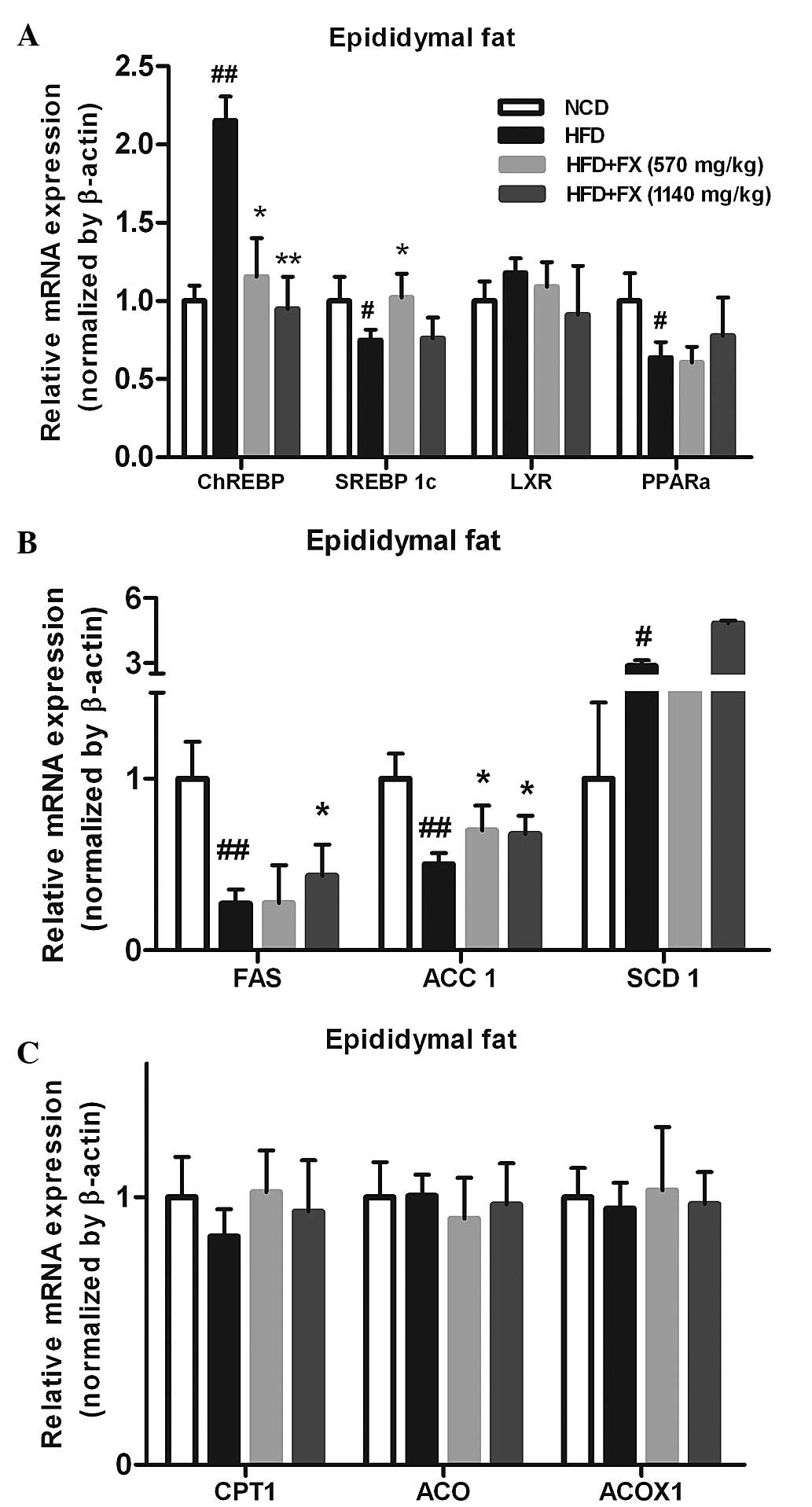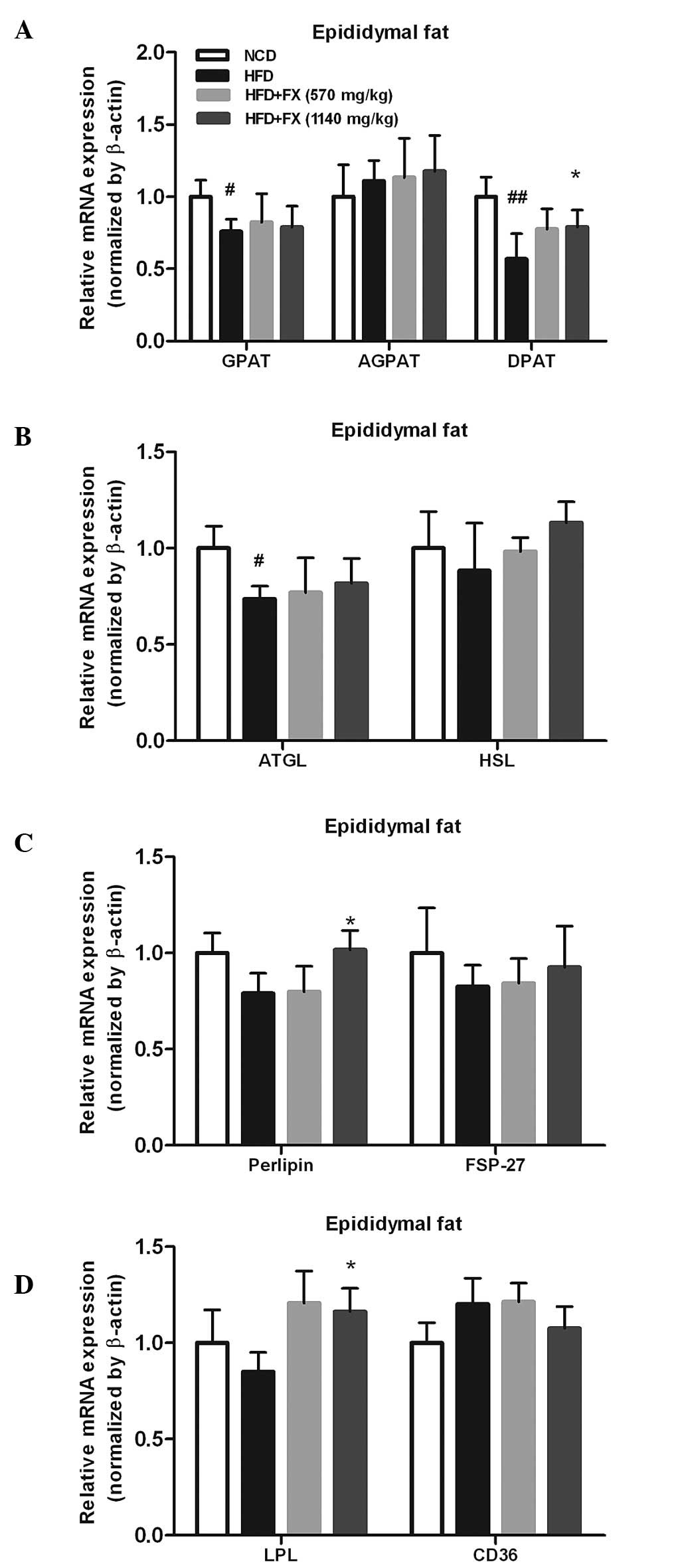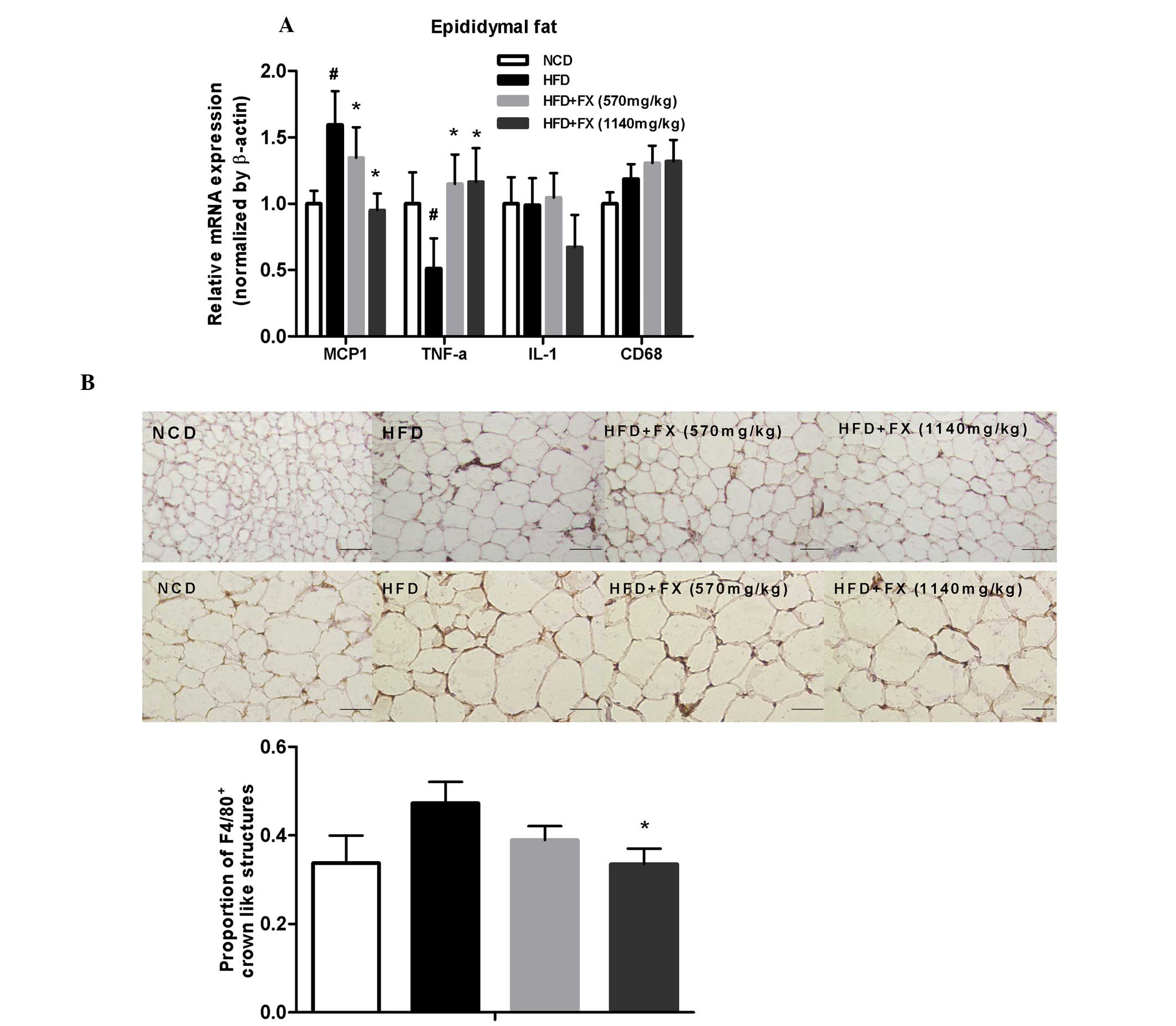|
1
|
Handschin C and Spiegelman BM: The role of
exercise and PGC1 alpha in inflammation and chronic disease.
Nature. 454:463–469. 2008. View Article : Google Scholar : PubMed/NCBI
|
|
2
|
Duval C, Thissen U, Keshtkar S, Accart B,
Stienstra R, Boekschoten MV, Roskams T, Kersten S and Müller M:
Adipose tissue dysfunction signals progression of hepatic steatosis
towards nonalcoholic steatohepatitis in C57Bl/6 mice. Diabetes.
59:3181–3191. 2010. View Article : Google Scholar : PubMed/NCBI
|
|
3
|
Postic C and Girard J: The role of the
lipogenic pathway in the development of hepatic steatosis. Diabetes
Metab. 34(6 Pt 2): 643–648. 2008. View Article : Google Scholar
|
|
4
|
Seo JB, Moo HM, Kim WS, Lee YS, Jeong HW,
Yoo EJ, Ham J, Kang H, Park MG, Steffensen KR, et al: Activated
liver X receptors stimulate adipocyte differentiation through
induction of peroxisome proliferator-activated receptor gamma
expression. Mol Cell Biol. 24:3430–3444. 2004. View Article : Google Scholar : PubMed/NCBI
|
|
5
|
Marcelin G and Chua S Jr: Contributions of
adipocyte lipid metabolism to body fat content and implications for
the treatment of obesity. Curr Opin Pharmacol. 10:588–593. 2010.
View Article : Google Scholar : PubMed/NCBI
|
|
6
|
Takeuchi K and Reue K: Biochemistry,
physiology and genetics of GPAT, AGPAT and lipin enzymes in
triglyceride synthesis. Am J Physiol Endocrinol Metab.
296:E1195–E1209. 2009. View Article : Google Scholar : PubMed/NCBI
|
|
7
|
Gimeno RE and Cao J: Thematic review
series: Glycerolipids. Mammalian glycerol-3-phosphate
acyltransferases: New genes for an old activity. J Lipid Res.
49:2079–2088. 2008. View Article : Google Scholar : PubMed/NCBI
|
|
8
|
Shindou H, Hishikawa D, Harayama T, Yuki K
and Shimizu T: Recent progress on acyl-CoA: Lysophospholipid
acyltransferase research. J Lipid Res. 50(Suppl): S46–S51. 2009.
View Article : Google Scholar :
|
|
9
|
Yen CL, Stone SJ, Koliwad S, Harris C and
Farese RV Jr: Thematic review series: Glycerolipids. DGAT enzymes
and triacylglycerol biosynthesis. J Lipid Res. 49:2283–2301. 2008.
View Article : Google Scholar : PubMed/NCBI
|
|
10
|
Gong J, Sun Z, Wu L, Xu W, Schieber N, Xu
D, Shui G, Yang H, Parton RG and Li P: Fsp27 promotes lipid droplet
growth by lipid exchange and transfer at lipid droplet contact
sites. J Cell Biol. 195:953–963. 2011. View Article : Google Scholar : PubMed/NCBI
|
|
11
|
Rodriguez-Cuenca S, Carobbio S, Velagapudi
VR, Barbarroja N, Moreno-Navarrete JM, Tinahones FJ, Fernandez-Real
JM, Orešic M and Vidal-Puig A: Peroxisome proliferator-activated
receptor γ-dependent regulation of lipolytic nodes and metabolic
flexibility. Mol Cell Biol. 32:1555–1565. 2012. View Article : Google Scholar : PubMed/NCBI
|
|
12
|
Wellen KE and Hotamisligil GS:
Obesity-induced inflammatory changes in adipose tissue. J Clin
Invest. 112:1785–1788. 2003. View
Article : Google Scholar : PubMed/NCBI
|
|
13
|
Sartipy P and Loskutoff DJ: Monocyte
chemoattractant protein 1 in obesity and insulin resistance. Proc
Natl Acad Sci USA. 100:7265–7270. 2003. View Article : Google Scholar : PubMed/NCBI
|
|
14
|
Kopelman PG: Obesity as a medical problem.
Nature. 404:635–643. 2000.PubMed/NCBI
|
|
15
|
Wanless LR and Lentz JS: Fatty liver
hepatitis and obesity: An autopsy study with analysis of risk
factors. Hepatology. 12:1106–1110. 1990. View Article : Google Scholar : PubMed/NCBI
|
|
16
|
Ma P and Li H: The research development of
Fructus xanthii. Chinese Herbal Medicine. 30:634–636. 1999.
|
|
17
|
Huang MH, Wang BS, Chiu CS, Amagaya S,
Hsieh WT, Huang SS, Shie PH and Huang GJ: Antioxidant,
antinociceptive and anti-inflammatory activities of Xanthii Fructus
extract. J Ethnopharmacol. 135:545–552. 2011. View Article : Google Scholar : PubMed/NCBI
|
|
18
|
Song MY, Kim EK, Lee HJ, Park JW, Ryu DG,
Kwon KB and Park BH: Fructus Xanthii extract protects against
cytokine-induced damage in pancreatic beta-cells through
suppression of NF-kappaB activation. Int J Mol Med. 23:547–553.
2009.PubMed/NCBI
|
|
19
|
Li XM, Li ZP, Xue M, Ou ZM, Liu M, Yang M,
Liu S, Yang S and Li X: Fructus Xanthii attenuates hepatic
steatosis in rats fed on high-fat diet. Plos one. 8:e614992013.
View Article : Google Scholar : PubMed/NCBI
|
|
20
|
Kato K, Takamura T, Takeshita Y, Ryu Y,
Misu H, Ota T, Tokuyama K, Nagasaka S, Matsuhisa M, Matsui O and
Kaneko S: Ectopic fat accumulation and distant organ-specific
insulin resistance in Japanese people with nonalcoholic fatty liver
disease. PLoS One. 9:e921702014. View Article : Google Scholar : PubMed/NCBI
|
|
21
|
Lument CN and Saltiel AR: Inflammatory
links between obesity and metabolic disease. J Clin Invest.
121:2111–2117. 2011. View
Article : Google Scholar
|
|
22
|
Kim JY, van de Wall E, Laplante M, Azzara
A, Trujillo ME, Hofmann SM, Schraw T, Durand JL, Li H, Li G, et al:
Obesity-associated improvements in metabolic profile through
expansion of adipose tissue. J Clin Invest. 117:2621–2637. 2007.
View Article : Google Scholar : PubMed/NCBI
|
|
23
|
Livak KJ and Schmittgen TD: Analysis of
relative gene expression data using real-time quantitative PCR and
the 2[−Delta Delta C(T)] Method. Methods. 25:402–408. 2001.
View Article : Google Scholar
|
|
24
|
Ginsberg HN, Zhang YL and Hernandez-Ono A:
Metabolic syndrome: Focus on dyslipidemia. Obesity (Silver Spring).
14(Suppl 1): S41–S49. 2006. View Article : Google Scholar
|
|
25
|
Sun X, Tang Y, Tan X, Li Q, Zhong W, Sun
X, Jia W, McClain CJ and Zhou Z: Activation of peroxisome
proliferator-activated receptor-γ by rosiglitazone improves lipid
homeostasis at the adipose tissue-liver axis in ethanol-fed mice.
Am J Physiol Gastrointest Liver Physiol. 302:G548–G557. 2012.
View Article : Google Scholar
|
|
26
|
Khan T, Muise ES, Iyengar P, Wang ZV,
Chandalia M, Abate N, Zhang BB, Bonaldo P, Chua S and Scherer PE:
Metabolic dysregulation and adipose tissue fibrosis: Role of
collage VI. Mol Cell Biol. 29:1575–1591. 2009. View Article : Google Scholar :
|
|
27
|
Hofbauer KG: Molecular patheays to
obesity. Int J Obes Relat Metab Disord. 26(Suppl 2): S18–S27. 2002.
View Article : Google Scholar
|
|
28
|
Alberdi G, Rodríguez V, Miranda J,
Macarulla M, Arias N, Andrés-Lacueva C and Portillo MP: Changes in
white adipose tissue metabolism induced by resveratrol in rats.
Nutr Metab (Lond). 8:292011. View Article : Google Scholar
|
|
29
|
Wang M, Grayburn P, Chen S, Ravazzola M,
Orci L and Unger RH: Adipogenic capacity and the susceptibility to
type 2 diabetes and metabolic syndrome. Proc Natl Acad Sci USA.
105:6139–6144. 2008. View Article : Google Scholar : PubMed/NCBI
|
|
30
|
Letexier D, Pinteur C, Large V, Fréring V
and Beylot M: Comparison of the expression and activity of the
lipogenic pathway in human and rat adipose tissue. J Lipid Res.
44:2127–2134. 2003. View Article : Google Scholar : PubMed/NCBI
|
|
31
|
Strissel KJ, Stancheva Z, Miyoshi H,
Perfield JW II, DeFuria J, Jlick Z, Greenberg AS and Obin MS:
Adipocyte death, adipose tissue remodeling and obesity
complications. Diabetes. 56:2910–2918. 2007. View Article : Google Scholar : PubMed/NCBI
|
|
32
|
Zhang HR and Zhang CH: Adipose 'talk' to
distant organs to regulate insulin sensitivity and vascular
function. Obesity (Silver Spring). 18:2071–2076. 2010. View Article : Google Scholar
|
|
33
|
Large V, Peroni O, Letexier D, Ray H and
Beylot M: Metabolism of lipids in human white adipocyte. Diabetes
Metab. 30:294–309. 2004. View Article : Google Scholar : PubMed/NCBI
|



















